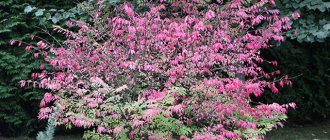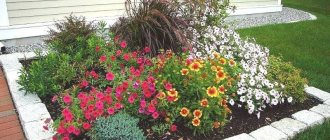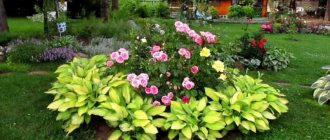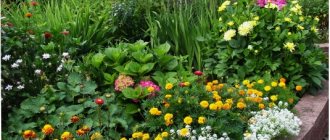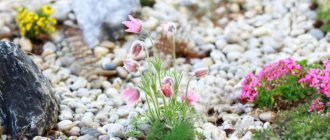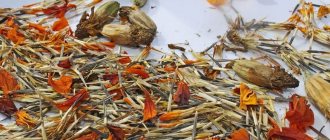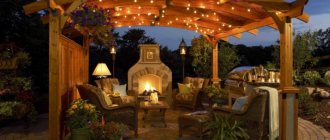Mixborder is a complex composition of flowers, shrubs, dwarf trees and various plants. Otherwise they call him flower border. It consists of annuals, perennials, ornamental shrubs, creeping conifers, creeping and liana plants.
Mixborders are very colorful. They are best set off by a plain background, for example, green coniferous plants, the walls of a house. And the most spectacular of them are made in one, two or three colors.
The decorative effect of a mixborder varies depending on when and what color the composition it composes blooms. Therefore, when compiling it, you need to take into account the growing season of the plant, its flowering, fruiting, decorative foliage, and color compatibility. If you correctly create a mixborder, it will delight the eye with flowering throughout the entire flowering season from spring to late autumn. And coniferous mixborders continue throughout the winter. It is difficult to create such beauty, especially for the first time.
Entrust it to our professional landscape designers!
Features of mixborders
The sizes of mixborders can be different. They are equally picturesque both on a modest plot and on a large territory. The minimum width is 1 meter. The maximum length is several tens of meters. In one fairly large mixborder, you can count up to 25 species of plants.
From the border and ridge, which have some common features, the mixborder differs in its freedom and smoothness of lines. The plants in it are arranged in small groups, smoothly transitioning into each other without sudden changes in color and height. It includes bulbous and root representatives, annuals, perennials, shrubs and even vines.
A little history
The idea of creating mixed landscape compositions belongs to the British. Their landscape style of plot design is simply unthinkable without picturesque multi-tiered plantings, including plants selected according to flowering time and degree of decorativeness and at the same time not requiring constant attention and careful care.
The first mentions of such methods of improving the territory date back to the 18th century. It was then, in contrast to the pretentious French design of borders, that natural, modest, but no less attractive, landscape groups appeared in English gardens, which over time received the name mixborder.
Mixborder placement
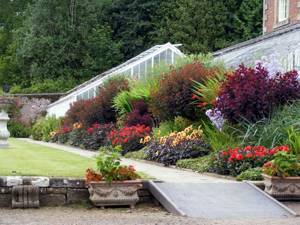
Experienced summer residents note that a more suitable place for arranging a flower garden is hidden from the burning rays of the sun (partial shade). Landscape designers usually plan a mixborder:
- Along the front of the building.
- On the slope.
- Along the fence.
- Near the roads in the garden.
A mixborder designed along the front side of the dacha requires taking into account the height of the window system so that the top of the flower bed does not cover them. Along the edge of the fence, plants must be planted at intervals from each other. This will allow it to grow. Mixborders near the fence are decorated more often. This makes it possible to hide the often unaesthetic appearance of the fence and visually level the boundaries. The landscape element has a supporting wall that forms the top of the landscape composition. A small mixborder should be properly arranged on a slope. It will help hide the disadvantages of the landscape and make them more aesthetically pleasing. And along the path, open mixes look good, viewable from anywhere on the site.
On a note!
By using the corner option, you can solve the problem of such places on the territory as compost or the corner part of the fence. Lush plantings can mask what needs to be hidden from prying eyes.
If the garden area is mostly in the shade, this does not mean that you should abandon the mixborder. A bright element will come from plants that tolerate sun deficiency well. It is good to plant crops with interesting names against the background of the lawn: hosta, rhododendron, lily of the valley, barberry.
Mixborder styles
Modern mixborders are very diverse. Based on the personal preferences of the site owner, they must also fully comply with the concepts of landscape design of the territory.
All styles in landscape design
Depending on the dominant plants, mixborders have different stylistic affiliations:
- English (landscape) style. Currently at the peak of popularity. Involves the use of flowering plants found in the wild (foxglove, delphinium, speedwell, echinacea), ferns and ornamental cereals (fescue, pennisetum, reed grass). In the background there are often conifers or large shrubs. This mixborder is distinguished by an abundance of greenery and restraint of floral shades.
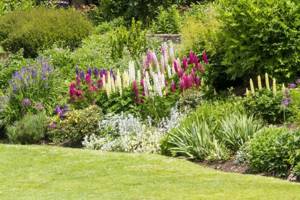
- Country. This design option is based on the use of simple rustic flowers, which have long been an integral part of every front garden (paniculata phlox, mallow, cornflower, rudbeckia, coreopsis).
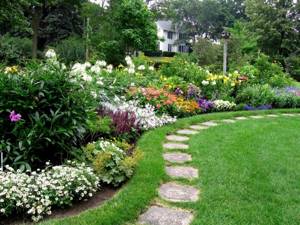
Basic rules for creating a mixborder
Since we are creating a mixborder with our own hands, in order to avoid mistakes, we must draw a diagram of the flower garden and distribute the plants, guided by certain rules.
- The largest plant in a mixborder should not exceed half the height of the distance from the plant to the viewing point (benches, paths, gazebos, etc.). If the height is greater, then the upper tier will be lost when viewing.
- The edges of mixborders should be clearly defined (this is especially true for flower beds located in the middle of the lawn or along paths). To do this, you can use small paving slabs, decorative stones or wooden chocks, and also make a border of low-growing perennials.
- We strictly observe tiering; tall plants should not cover lower ones.
- Do not try to use as many types of plants as possible in the flower garden (there is a rule - no more than 3 species per 1 sq.m.).
- When planning the shape of a flower bed, avoid overly clear straight lines; the beauty of a mixborder is in smoothness, elegance and naturalness.
When selecting plants, be sure to consider the following:
- Unpretentiousness (do not plant plants that are difficult to care for or require serious shelter in winter).
- It is better to place plants with similar requirements for growing conditions (lighting, watering, type of soil) in one flower garden.
- Vigorous species should be avoided, as well as those with a powerful superficial root system, as they can gradually spoil the entire flower garden.
- Take into account the timing of flowering; it is necessary to select plants that bloom in the dacha all summer one after another and retain their decorative effect after it.
- Give preference to perennials; they will form the basis of your flower garden for years to come.
- All species must be equally resilient and not afraid of competition.
- Follow the planting standards, do not chase density, because the plants will grow over time, especially since the gaps can be filled with annuals.
Location and forms
In addition to style features, mixborders also differ in location and shape. Based on these characteristics, they are divided into the following types:
- Unilateral. Ideal for small areas. Such compositions are usually clearly visible from one angle, but from another they are limited in the form of a wall or hedge, often entwined with vines. The tallest plants in these flower beds are located in the background.

- Freely located. They are characterized by unlimited access from all sides, therefore, to create a harmonious composition, the largest plants are located in the central part with a gradual decrease in height towards the edges. When planning such mixborders, it is important to remember that the height of the largest plants in them should not exceed half the width of the allotted space.

- Corner. They decorate and fill empty corners in areas. The largest and most spectacular plant is planted in the center of such a composition. On both sides it is complemented by vines that camouflage the walls or fence. As a rule, shade-tolerant crops predominate in such mixborders.
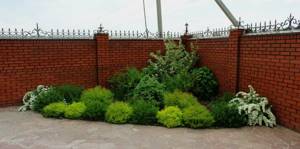
Scheme 1. Beautiful flower garden of perennials
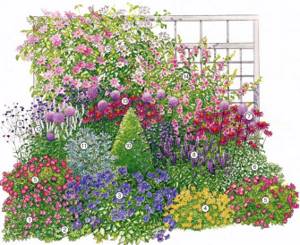
Let's look at this example in more detail. In the bottom row are the following flowers:
- Bloodroot. It blooms in mid-summer; in autumn the plant “puts on a dress” of golden color.
- Coreopsis. It blooms for a long time, sometimes until the first frost. The flowers are yellow, the shade may vary.
- Geranium is majestic. It blooms for only 40 days, but in the fall it takes on a beautiful brick shade.
- The cuff is soft. If you like the yellow section design, check out the cuff. Its yellow flowers are shaped like clouds, although gardeners plant its mantle solely for its lush leaves.
- Geranium Endressa. A versatile plant that will bloom almost all summer. In autumn, and then in winter, you can decorate your flower garden with leaves with an interesting dark green tint. Even -30 degrees geraniums are not scary.
The middle row consists of plants such as yarrow ptarmika (6), decorative onion (7), fennel grass (8), verbena (9), boxwood (10), decorative wormwood (11). We recommend paying special attention to the decorative bow, which looks very beautiful. Verbena can bloom before the onset of severe frosts, boxwood is easy to care for, and decorative wormwood has unusual lacy leaves.
The mixborder from the diagram consists of four plants in the background:
- Lofanta. It is notable for the fact that it blooms from early July until late autumn. It is characterized by a spectacular appearance and great splendor.
- Purple coneflower with beautiful flowers but completely unsightly leaves.
- Hatma, often reaching 2 meters in height.
- Clematis. May have velvety flowers in pink and blue shades.
The plants described above have similar needs for soil acidity, watering, and light. They are not demanding in care, so you can water and feed them in combination.
Color solutions
When planning a mixborder, after determining the shape and style, it is important to choose the color scheme of the composition. It can be based on a combination of contrasts or, conversely, on complementing some shades with others. The latter option looks more elegant and noble, but requires a particularly careful selection of plant material.
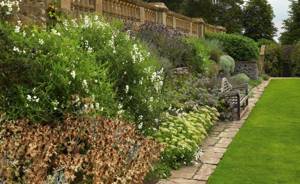
Multicolor compositions are suitable mainly for large areas, since their beauty can only be fully appreciated from a certain distance.

A mixborder designed in pastel colors is considered almost universal, harmonizing with any environment. Unobtrusive combinations of soft pink, light lilac and yellowish shades, framed by silvery greenery, will enliven the landscape and, attracting admiring glances, create a special romantic atmosphere.
Choosing a place to plant a mixborder
The choice of location is a decisive factor in determining the type of composition. If a flower bed is laid out along the facade of a building or used to decorate a fence, then we will be talking about a one-sided flower bed.
You may be interested in: DIY Alpine slide: design, planning, seating
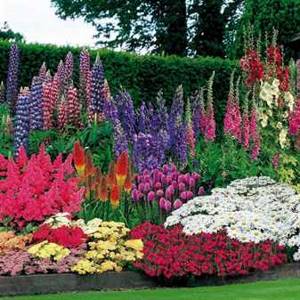
Using the same principle, a mixborder is built that frames garden paths, or a flower bed as a hedge. Photo:
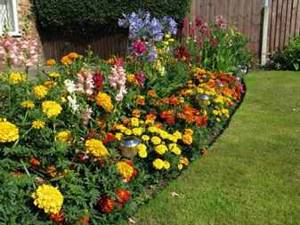
A mixborder located on a lawn or open area should be visible from all sides, which means this is a different planting scheme.
It is also important to take into account this aspect: the distance from the viewing point to the decorative composition should not be less than the height of the highest supporting element.
Since the choice of plants for such compositions does not limit the preferences and capabilities of gardeners, placement is allowed both in sunny areas and in the shade. The choice of perennials that prefer certain conditions is rich, so putting together a composition of shade-tolerant or light-loving plants is not difficult.

If the territory allows, then a combined mixborder option is possible, which occupies a fairly large area, where there are areas with bright sunlight and shaded areas. This allows you to further diversify the design of your flower garden by planting plants that prefer different levels of light.
Rules for arranging mixborders
In any business, in order to achieve your goals, you should first draw up a plan of proposed activities. Creating a mixborder is no exception. It is advisable to carry out all work on its organization in the following order:
- Determination of place . Mixborder can: - occupy an empty corner; - sit along the path or in the middle of the lawn; - decorate the external boundaries of the site. Having decided on the territorial issue, you should conduct a visual assessment of the degree of illumination of the selected area. It would also be useful to become familiar with the composition of the soil. This will help you accurately select the right plants.
- Development of planting scheme. To avoid mistakes associated with poor placement of plants, experts recommend first drawing up a sketch plan for the future mixborder.
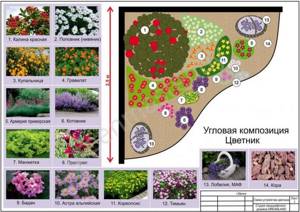
Small flowers and herbs (up to 40 cm) are planted in the foreground. Behind them are medium-sized ones (up to 60 cm). The composition is completed by representatives of the flora with a height of one to one and a half meters.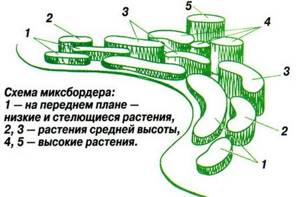
When choosing plants for a mixborder, you should take into account the timing and duration of their flowering. With the proper arrangement of the component elements, you should get an unfading flowerbed, harmoniously complemented by decorative greenery. - Plant selection . It is carried out in accordance with the illumination of the site, the composition of the soil, the degree of moisture and protection from the wind. When creating a mixborder, you should consider a few simple rules: - you should not place plants with different needs for watering and fertilizing nearby, because by moistening some abundantly, you can destroy others. — It is better not to use fast-growing plants with a strong root system; they can drown out and completely displace their neighbors. — It is important to pay attention not only to flowers, but also to greenery - decorative foliage will give the mixborder additional volume and picturesqueness.
- Soil preparation . Directly depends on its composition and the selected plants. Soil treatment before planting is usually carried out to the depth of the root system with a margin of about 10 cm.
- Planting vegetation . The process of filling a mixborder traditionally begins with the so-called skeletal plants. These are the largest components of the future flower garden, determining its volume and height. In addition to conifers, some types of shrubs cope well with this task: mock orange, viburnum, lilac, hydrangea, felt cherry, forsythia. Considering that such plantings are prone to growth, you should not place them too close to each other. The next stage is planting perennials. It is recommended to distribute groups of plants blooming at the same time evenly throughout the mixborder, alternating them with other crops, thereby setting a certain dynamics. And finally, to complete the composition, the gaps between the plants are filled with decorative annuals. Objects located directly at the edge of the mixborder must retain their attractiveness until the onset of cold weather.
When planting a wide flower bed, it is important to provide for the possibility of its maintenance. To carry out weeding, pruning and watering, small passages should be arranged on the back side or decorative stone platforms from which there is access to certain plants.
Leave a request for a consultation
Types of mixborders
It cannot be said that there are strictly defined types of mixborders: here the imagination of designers, gardeners and summer residents can operate without limits. But there are certain rules and instructions that are recommended to be followed when compiling them:
Double-sided mixborders - located along roads or paths so that the paths are located on both sides of the same flower bed. Then the mixborder will be visible from both sides. When creating a double-sided mixborder, low plants are planted along the edges, and tall plants are planted in the middle. Shrubs, tall plants, ornamental tall roses, ornamental flowering shrubs, dwarf and low-growing trees can grow high.
But closer to the edge of the mixborder you should plant low-growing, dwarf, creeping plants and flowers, or end it with lawn, low-growing grass. The level of plant growth should be reduced to the border of the mixborder along its entire width. The double-sided mixborder should be positioned so that the tallest plants are at eye level when the viewer is at a distance of 2 meters.
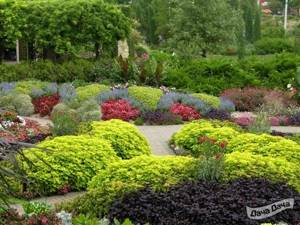
.
One-sided mixborders - they are placed against the background of a fence wall, a house, tall trees or shrubs, hedges, if they are made of plain, weaving, green shrubs. In the background are tall ornamental shrubs, conifers, and vines. In the middle are plants and flowers of medium height, and in the foreground are ground cover, creeping, low plants and flowers blooming. Sometimes lawn grass is planted along the entire edge of the border.

Shrub mixborders - planted over a large area, sometimes very large and wide, in comparison with flower mixborders. It is made in such a way that the plants do not shade each other, but at the same time they can be viewed from all sides. Therefore, plants are planted so that they are visible from all sides.
Each type of shrub must fully develop in a certain area, so a shrub mixborder is, first of all, space. But shrub mixborders are placed in different ways - along the walls of the house, terraces, fences, gazebos. Another rule is that shrubs in a mixborder are selected so that they can be shaped. These can be: tree peonies, spirea, rhododendrons, barberries, honeysuckle weigella, flowering and fruiting yew, conifers, coniferous-heathers, boxwoods.

Coniferous mixborders - planted as single-sided or double-sided. Their basis is skeletal coniferous trees, which can be quite tall, in the background, followed by medium-sized ornamental coniferous shrubs and only then low creeping conifers. In summer, coniferous mixborders can be a decorative background for flower beds, and in winter they can be the main characters. In their composition you will find blue spruce, cypresses, Korean firs, curly pine, mountain pine, and creeping juniper.
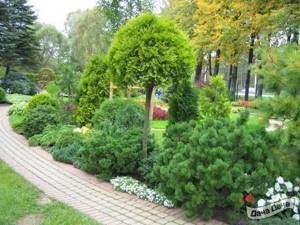
Floral mixborders are a mixed flower garden of perennial and annual flowers, maintained in different styles using tiers and continuity of flowering. Having created a flower mixborder, you will enjoy its flowering for almost the entire season - from spring to late autumn. The combination of flowers from different growing seasons creates the most spectacular flower garden of all.
In it you can plant flowers of different shapes, with different leaves, of different splendor, which makes this type of flower garden the most picturesque.

Rules for creating mixborders
The basic rule is that the height of the tallest plant should correspond to the width of the mixborder. This creates harmony in the composition. The width can be a little more than one and a half times and no more. Otherwise the harmony will be broken.
Flowering mixborders can have very different shapes: curved, oval, geometric, fantasy. The area should be calculated depending on the height of the tallest plant and the viewing angle of the mixborder.
It is better to look at and admire flower arrangements from a certain distance. For example, you have a gazebo in your garden. To appreciate the beauty of a flower garden, your misk border should be located at a distance from it equal to the height of the tallest plant.
The dimensions of the plants must be taken into account if your mixborder is planted from perennial plants and it will be difficult to move it to another place after summer flowering. Therefore, when planting, you need to leave room for the plant to grow and develop until the end of its growth and growing season.
If the mixborder is located in the entrance area to your site, then you need to take into account the scale of proximity to the house and the architecture of the house in order to create an appropriate composition. If its place is near the gazebo, then you need to emphasize its height by placing a low mixborder nearby.
When placing perennials in one flower garden, without annuals, you need space for the future growth and development of perennial plants and you should also make room to comply with the principle of tiering from the beginning of planting the flower garden. After all, as already mentioned, they grow and if they are planted too closely, they will choke each other. But replanting perennials is both difficult and not recommended - that’s why they are perennials.
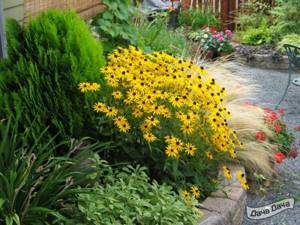
Plants for mixborders
What is the best way to choose plants for mixborders? If you plant different flowers, combining perennials and annuals, then you need to choose varieties that have the same sensitivity to the sun and light. Because, having planted shade-loving ones together with light-loving ones, you will see that the shade-loving ones withered and closed their cups on a sunny day. And there is nothing to admire here. And if you plant plants that love the sun in partial shade, they will rot, wither and get sick without light.
Soil moisture must be taken into account. Moisture-loving plants will not accept dry soil; disastrous results await them on it. And plants that like dry soil will not do well in wet soil.
Please note that it is better to plant moisture-loving plants in lowlands, where it is usually humid. And drought-resistant plants are found at higher elevations, where it is always drier. If you have a flower garden, then the roots of all flowers should not be different, where some branch widely, while others grow vertically downwards. It is necessary to select plants with small roots, or roots growing vertically downwards. Because a mixborder is a compact flower garden, and there is not much space for flowers. The main goal is for the flowers to bloom together. And this is impossible if some roots take food from other roots. The root of each plant must receive adequate nutrition.
If the roots grow vertically and in breadth, then the plants need to be thinned out in a timely manner. Otherwise, they will feed on substances that other flowers need. In order for plants to grow lushly, the soil composition must be suitable for all plants in the mixborder. If there are bulbs in the mixborder, which are cut off after flowering, then their place remains bare. You can plant annuals there.
When creating a mixborder composition, you must know the growing season of plants: periods of budding and flowering should occur evenly in the mixborder. This is necessary so that the flower garden always blooms, while some flowers are in buds, others are blooming, and still others are fading. This is the main highlight of the flower mixborder.
Experienced landscape designers recommend adding plants with unusual, textured leaves to all mixborders, for example, ferns, wild rosemary, bergenia, and daylily. Larger plants should be planted a little randomly. This will give the mixborder a natural and natural texture. Contrasting mixborders are best made from red and green, red and pale pink, blue and yellow. For monochrome flower beds, it is very good to choose pastel colors - pink, soft yellow, cream. For variegated mixborders, alternate colors to avoid bad taste.

Don't go astray
When creating a mixborder, proceed in stages. First, figure out what shape it will be, then choose a place on the site for it, prepare the soil - we will talk about this separately, describing the types of mixborders. Think about how the mixborder will end - stones, a brick border, a lawn, beautiful crushed stone. If you have a large mixborder of ornamental shrubs, then carefully calculate the location, having first measured everything. For example, Bergmann pine, honeysuckle, barberry grow widely, with spreading branches, and you need to measure the spread of the crown of the bushes.
Then plant large trees, they are also called skeletal trees. The second tier is medium-sized bushes. After this, shrubs are planted according to plan, if they are included in the plan. Dwarf trees are planted below the bushes. Following them are ground cover plants. Plant in such a way that the ground cover shrubs cover the root part of the tree trunks. In flower beds it’s the same - first the top, then the bottom. If you do everything according to plan, taking into account the nuances that we talked about, then you will have a beautiful mixborder on your site that will delight you and your guests throughout the summer season. And if you manage to plant a coniferous mixborder, it can even become a decoration of the garden in winter.
Better yet, leave it to our professional landscape designers!
Flower selection criteria
When choosing plants for a mixborder in your garden plot, it is recommended to pay attention to the following basic criteria:
- Biological needs of flowers. Before planting, it is worth studying the requirements of the selected specimens for the composition of the soil, the level of humidity and illumination.
- Plant compatibility. The selected specimens must be in harmony with each other.
- Flower garden style. To prevent the mixborder from turning into an ordinary flower bed, you should strictly adhere to the chosen style. It is also not recommended to mix exotic plants with forest ones.
- Duration of flowering. By choosing specimens that are characterized by long-lasting flowering, you can create a flower garden on your site that will be full of bright colors almost all year round.
It is not recommended to plant plants with different feeding and watering needs in close proximity, since excess or lack of nutrients and moisture can destroy the plantings.
Video: basic principles of plant selection
Types of plants for mixborders
For beginning gardeners, we present a small list of plants that can be planted in different flower garden plans.
tall plants
Trees. All types of vertical conifers slowly growing to a small height, willow, viburnum, magnolia, jasmine, spirea, barberry.
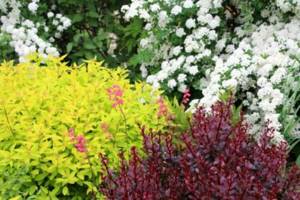
Bushes. Clematis, Hibiscus.
Flowers. Lupine, delphinium, rose stock, iris, phlox, rudbeckia, English aster.
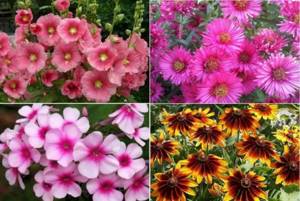
Plants for the middle row
Flowers. Decorative onions, verbena, decorative wormwood, speedwell, medium types of irises, flax, chistets, astilbe, peonies, roses, lilies, chrysanthemums, echinacea, mint.
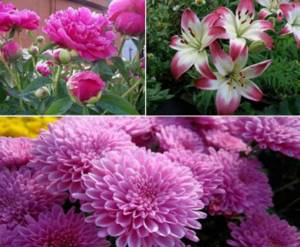
Bushes. Cinquefoil shrub, rhododendron, azalea.
Foreground decoration
Flowers. Coreopsis, geraniums, mantles, sedum, heather, violet, campanula, low-growing perennial asters, Turkish carnation, primroses, tulips, daffodils, pushkinia, galanthus, muscari, ageratum.
Decorative deciduous. Small forms of hosta, cineraria, heuchera, bergenia, saxifrage, young.
Selection of colors
The color scheme of the mixborder is also important. The selected plants must be compatible with each other in color. The contrasting type is suitable for small plantings. The basis of such a flower garden is a combination of contrasting shades, for example, gray and red.
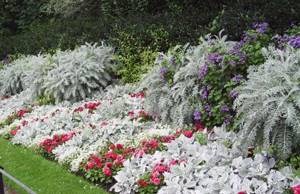
A contrasting type mixborder looks good in small garden plots
The monochrome type of mixborder looks restrained and attractive, which involves placing plants of the same color in a flower garden, but in different shades.

A monochrome mixborder is easiest to create from coniferous plants and shrubs
The polychrome mixborder looks catchy and interesting. In such a flower garden it is customary to plant plants of 5 different shades.
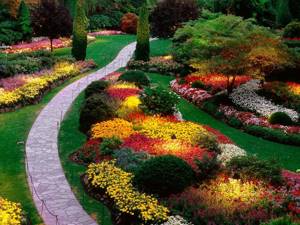
In a polychrome mixborder, colors that complement each other are planted, such as red, white, purple, green and yellow.
It should be borne in mind that in a polychrome flower garden, green should serve as the background.
How to plant a mixborder with your own hands
Creating a complex flower garden is not an easy task, but anyone can do it. Having a detailed diagram and having prepared the necessary plants, you can begin preparing the site: you need to dig up the ground and very carefully clean it of roots and weeds.
According to the mixborder plan, immediately prepare planting holes of the required size for each plant, not forgetting about fertilizers and drainage.
First of all, the highest support level is planted - “skeletal” plants. Their height must be at least a meter. This is followed by mid-level plantings - up to 60 cm. The shortest specimens are planted last.
At first, the mixborder will not meet the gardener’s expectations, because the seedlings need time to grow and occupy the entire territory allotted to them. Therefore, to fill the voids in the first two or three seasons, you can plant annual flowers that match the color scheme. It is possible to place such “fillers” directly in pots so as not to disturb the ground cover plants.
Watch the video for more details:
Varieties and styles
Experts distinguish only 2 types of mixborders:
- Flower bed with one-sided view. It is located along fences and walls, as well as on hillsides. The flower bed is also used as a natural fence around the perimeter of the site. Tall specimens are placed in the background, and dwarf ones in the foreground.
- Island flower bed. This flower garden can be admired from all sides. In it, the tallest specimens are located in the center, and the lowest ones are located at the edges.
There are also the following styles of such flower beds:
- English;
- rustic;
- meadow;
- garden;
- shadow;
- shrubby;
- coniferous.
English

The English style is characterized by restraint and calmness of colors
The English (garden) style is classic, since the English are considered the founders of the mixborder. Flower beds of this type are distinguished by restraint and brevity. In its classic version, it successfully combines pale pink, purple and burgundy tones with muted green shades. Mandatory elements in the English mixborder are meadow flowers. Different varieties of roses are also planted there. Phlox, peonies or poppies become a bright accent in such a flower garden. Designers most often prefer to dilute ornamental plants with cereal specimens or voluminous heather.
Video: landscape designer’s recommendations for creating an English-style flower garden
Rustic

A mixborder in a rustic style is characterized by many colors and an abundance of greenery
A rustic mixborder is also called a country-style flower garden. It is distinguished by an abundance of bright colors. Only garden specimens can be planted in such a flower garden, for example, dahlias, tulips, irises and petunias. Climbing roses and sunflowers add spice to the country style composition. Berry bushes create a special rustic atmosphere in this composition.
In a rustic mixborder, an abundance of different shades is welcomed. There are no color restrictions at all.
Lugovoy
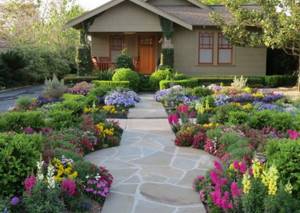
This mixborder is as close in appearance as possible to a natural meadow landscape
Meadow (landscape) style is expressive. There are no bright accents in it. An obligatory component in such a flower garden are cereals. They are successfully complemented by daisies, cornflowers and bells. Conifers, low-growing trees and shrubs are often planted in a meadow mixborder.
Shadow
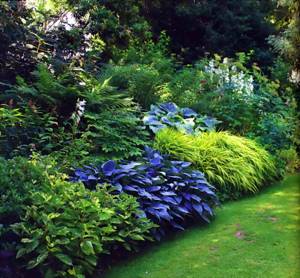
The shade mixborder is an excellent landscape solution for areas with low light
The shade mixborder is formed from shade-tolerant specimens. The main colors in this composition are green, red, white, brown and pink. Conifers, as well as rhododendrons, violets and tiarellas, are most suitable for growing in the shade.
Video: overview of the mixborder on the shady side of the site
Garden
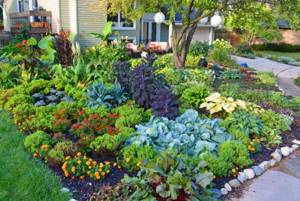
An unusual mixed flower garden is a mixborder with a garden style
The garden mixer uses the principle of mixed vegetable plantings. At the same time, it takes into account the compatibility of cultures. You can plant any vegetables in such a mixborder. It is allowed to add medicinal and spicy herbs to the plantings, which stimulate their development and growth, and also complement the composition. Such a mixed flower garden not only looks very attractive, but also produces a rich harvest by autumn.
Shrubby

Shrub mixborders remain decorative all year round
In such a mixborder, perennial shrubs with unusual leaf shapes are planted. These specimens perfectly complement flowering and evergreen plants that do not lose their attractiveness in winter. Coniferous wood becomes an interesting accent in such a composition.
Video: review of the bush mixborder
Coniferous

Coniferous mixborders look attractive at any time of the year
Coniferous mixborders look very extravagant and unusual. To create them, specimens with interesting needle colors are used. Shrubs of unusual shapes and decorative perennials, which are distinguished by bright flowers, are added to the conifers.
Watch the video: Beautiful mixborders in landscape design 50 photo ideas
How to make a mixborder, there are many beautiful plants that grow in acidic clay soils and love them very much. These are mostly unpretentious plants. A mixborder should be made from them. Choose the design of mixborders photo:

- Dry stream: perfect for any garden style
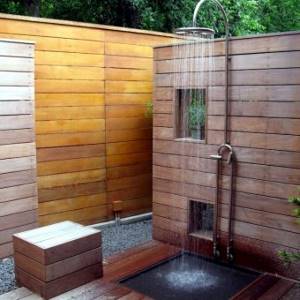
SHOWER CABINS: SIZE AND SHAPE

How to choose and install a profile for aluminum steps

What is a mixborder
The name mixborder comes from the French words meaning mixed border or border. And, indeed, the translation speaks for itself. The mixborder is necessarily limited, and various plants are planted inside it. A mixborder is a flowerbed, limited by something, having various geometric shapes. But the main thing is that it consists of different types of plants. Which is very important for inexperienced owners, because it can be very difficult to immediately select crops that combine with each other.

